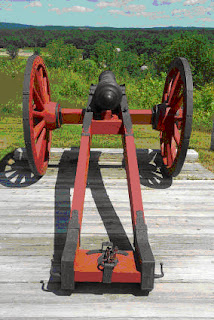So today was the reenactment of both the first and second battles at Trenton; I attended the second. The actual battle occurred January 2, 1777, with the British essentially charging three times the bridge across the Assunpink Creek, and being repelled three times by the Continental forces. In this interpretation, the British and Hessians battle the American forces on what is now called Broad Street (then, Queen Street). I managed to get "flash" as they fired.
Here are the Americans:
Here are the Americans:
And facing them, the British:
Mill Hill Park is where the main British assaults occurred; here is a representation of the British artillery firing on the American position:
The yellow house is the Douglas House. It was originally on Queen Street south of the creek, and was eventually moved to its present location after other moves. Washington held a council of war in this house on January 2.
Kudos to the reenactors; watching them and listening to the officers bark commands (in German, for the Hessians), and watching the process of loading and firing, in such close proximity, drives home just how personal this war was. Unlike the drone operator moving around a joystick, these men looked, quite literally, into each other's eyes as they fired.












































